Seen as One…Yet the Sum
- By Finn Ward

-The moss green hull slides softly through the water as my paddle cuts, creating small whirlpools. A little green heron hops away in the twisty brush. The trees meet overhead, weaving together to make a cathedral-like passage through the marsh. I look down at my wooden canoe; every part feels inviting, and comforting. The solidity of the craft feels reassuring. What a beautiful canoe, I think to myself, and I made it. Okay, I made it with some help.
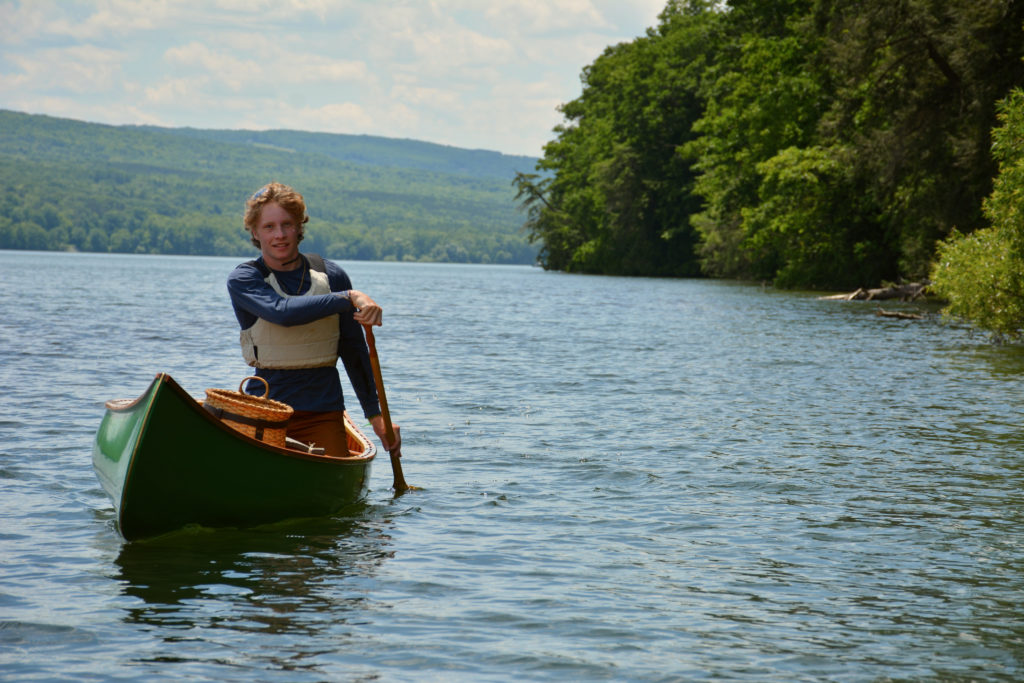
It all began in November of 2018. Earlier that year, my Dad contacted Mr. Patrick Smith of West Hollow Boat Company (Naples, NY) and asked him if he’d be interested in teaching me to build a canoe. Dad would be there too, helping and learning, but really it was an opportunity for me to learn an incredible form of craftsmanship from a respected, extremely experienced and talented cedar canvas canoe builder. I don’t think my Dad actually thought it was going to happen, but Mr. Smith agreed, and the journey began. (I’m a student at the Walden Project, NY, and this great opportunity to build a canoe was possible because of the vision, flexibility, and guidance of this program. For this I am grateful.)
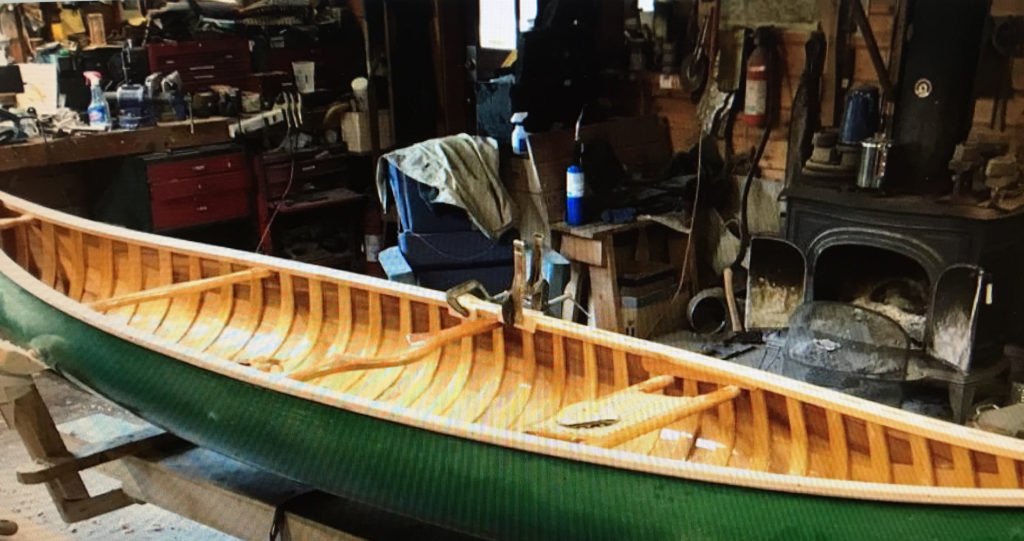
First, I met Mr. Smith to see his shop and talk a little bit about the history of the cedar canvas canoe. The shop is exactly what you’d expect. It is warmed by a wood stove with a coffee pot on top, and full of the scent of cedar. Canoe forms, old canoes in repair, canoes hung from the ceiling, tools, cedar dust, and all kinds of cool old quotes and pictures are tacked to the walls. Mr. Smith explained how the design comes from the Native American birch bark canoe, favorite shapes coming from the Malecite and Ojibway people. We will be using painted canvas in place of the bark, and tacks and nails instead of spruce root lashings and American hornbeam pegs, but otherwise most of the materials are identical. He discussed how the first cedar canvas canoes were built in Maine and the technique adopted by the Canadians. He spoke of the first builders, like E.H. Gerrish and B.N. Morris and of course the Old Town Canoe Company. He even showed me canoes that he was restoring that were over a hundred years old. I could tell how much Mr. Smith admired the workmanship of the old builders and how he felt connected to them. As he described each boat his hands rode along the thwarts to the gunwales and on to the carved decks. His connection to these men and the boats they built is powerful. They may have been forgotten by some, but not Mr. Smith. I glanced over to Dad, nodded, and he smiled. We both knew this was going to be incredible.
The Build Begins
Dad and I show up early in the morning. The shop is warm, smokey, inviting. Mr. Smith and his dog Teaks greet us. Right away we are at work, sanding white cedar ribs that have already been planed to 5/16th thickness. We need 36 of them and we do a few more just in case we break some. This white cedar comes from the Adirondacks and is a traditional material.
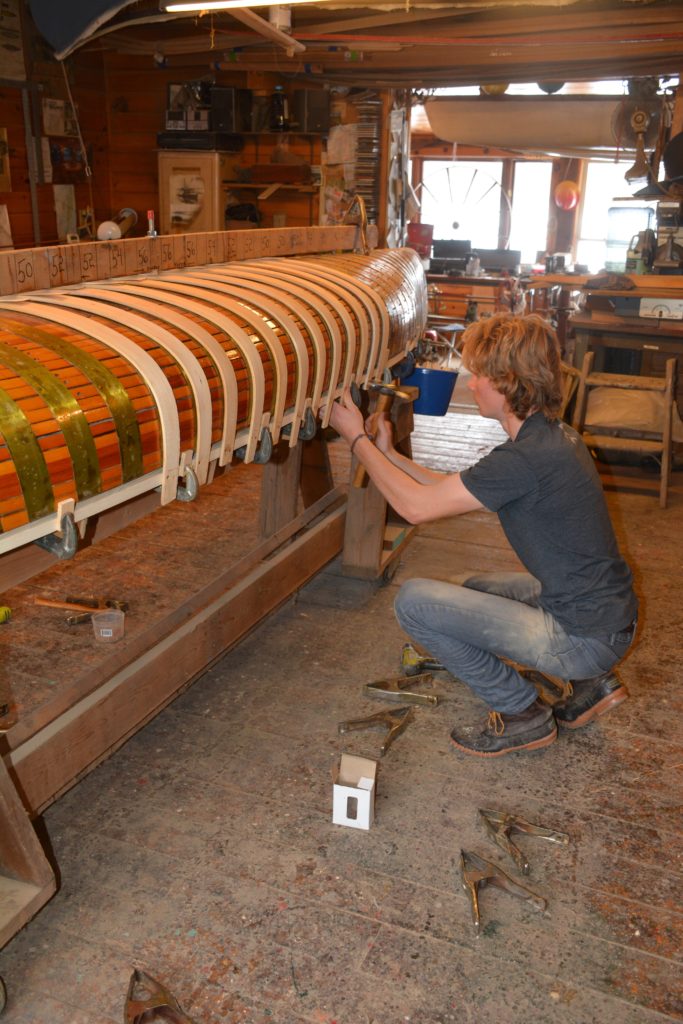
You should know that Mr. Smith has already placed the stems and inwales on the form. The stems are pre-shaped on a jig. They are of white ash, a strong and flexible wood. He steamed them to help the wood take the strong shape of the curved bow and stern. The inwales, also of white ash, follow the upper edges of the canoe. They will be softly shaped and comfortable to the hand. The form is what I build the canoe around. It is beautiful by itself and without it the building of my canoe would be much more difficult. The Native American birch bark canoes were built without forms. Instead, they were constructed on the ground, beginning with the outer most layer, then stems and inwales, planking, and finishing with the ribs and outwales. White Cedar was the chosen material for ribs, planking, inwales, outwales and stems. The American white or paper birch bark was used for the canoe’s outer layer.
I can feel the comfortable heat of the steam as I slide six of the clear shaped ribs carefully into the wooden steam box. They will be surrounded by heat for thirty minutes. The heat softens the long fibers of the cedar allowing us to bend it. After fifteen minutes we’ll add another six. In this way we’ll have fifteen minute windows to place six ribs. Having some spare time as the cedar warms, I sit in a nearby chair, clear my mind, and prepare for their installation. With each passing minute, I could feel stress accumulating in my body. This boat means so much to me. I want to do my best and avoid mistakes that lead to waste. The White Cedar is here for me to use, but carefully.
“Time,” says Mr. Smith. He pulls a steaming hot rib from the box and hands it to Dad. Dad looks at it somewhat puzzled. He has to figure out which way to place it on the form. Each of the ribs is tapered and they each have an arrow at the center point. This helps us figure that out. Dad places the rib beneath the strongback, secures it with a wedge and then carefully, but quickly we both bend or shape the cedar rib to the form. Once the end of the tapered rib contacts the inwale, we clamp it, then try to get a nail in before…
“Time, here comes another one, get on it,” says Mr. Smith (with a little chuckle, I might add). And so it goes. We learned that the cedar bends well, but only if you do it quickly while it’s hot. Some ribs do fail, the wood fibers unable or unwilling to flex and bend.
Thirty six ribs were shaped around the form and copper ring shank nails, two at each end, hold them firmly to the inwales. (Not exactly what the Indians used. They had to lash nearly every part of the canoe. The lashing was of peeled and split spruce root.) The ribs must adjust to the shape of the form. The Cedar fibers need to rest, relax, dry and accept their new fate. This takes time and then some fairing to take down the high spots.

I adjust my weight, heeling the canoe to one side. I push the boat until the outwales are nearly touching the water, to what’s called the point of secondary stability. It’s not easy to get past the feeling that the boat is going to flip, and sometimes it does, but once you achieve this stable position the boat can spin like a floating maple leaf. Just touching the water with the paddle makes the canoe begin to spin. And that is what I want.
Heeling the boat lifts the bow and stern out of the water, so now the boat lies on its beautifully rounded side. Can you picture this? I am kneeling in the boat just behind the carved black cherry yoke, the boat is heeled hard to my right side and my paddle is held straight with one hand high, the other at the water. The boat lies in perfectly calm water, with unusually still cattails nearby. From behind comes the distinctive call of the small common yellowthroat. Slow, quiet paddle strokes move the boat through this twisty section of marsh. A pull, then a slight turn of my top hand and the canoe glides peacefully and accurately through the water. A green darner hovers to my left, and then a Red Calico. (I call them Red Calicos, but a more accurate name is Calico Pennant). Both are magnificent in appearance and imposing as predators.
Off in the near distance are tall, deep green hemlock trees, hundreds of feet high, with thick trunks and weather worn branches. They are a small group of old growth hemlock trees, surviving only because they were not accessible to the loggers. I’m glad they are here, but they remind me of human stupidity and greed. Now they are protected, but if they were not they’d be gone too.
I’m leaving the closed in quiet marsh to paddle the more open waters of the lake. I change position in the boat, lessening the heel, allowing it to track. Lifting the paddle from the cool, clear water of the smallest Finger Lake, Canadice, a droplet of water falls to the floor of my canoe. Instead of weakly spreading and disappearing, the droplet’s surface tension holds it together. It magnifies the beauty of the cedar planking which reminds me of when Dad and I placed each of those planks.
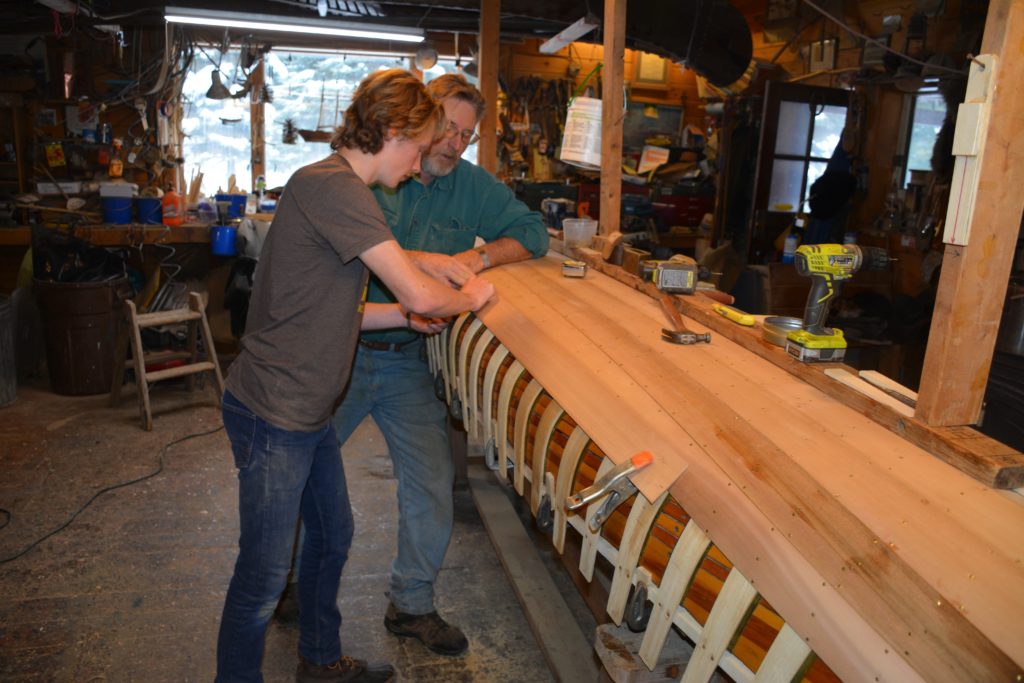
The planking material we chose is western red cedar. It is a strong alternative to the eastern white cedar that is not so easily available in long lengths. Thick stocks of cedar boards were milled to plank dimensions, 5/32 inches in thickness and 3 1/4 inches wide of various lengths. I carefully select a plank, looking at the grain of the wood, the color, and for blemishes. Then I sand it and lay it along the centerline of the canoe. This first plank must be placed perfectly and is done so by Mr. Smith. It stabilizes the frame (the ribs), making most movement cease. This is the garboard, a guide for the remaining planks.
Some old wash cloths lie soaking in a pot of boiling water on the stove, steam rising, forming small clouds which slowly dissipate in the dusty air. I remove the hot cloths and situate them along the plank. This heats the wood fibers, softening them, and allowing for the radical bending, especially at the bow and stern. The plank is clamped in position and ready for tacking. I begin at the center, placing 5 brass tacks forming an X. The tacks are short, sharp and soft. They push easily through the cedar plank into the rib then clinching over as the tip hits the steel band on the form. We do this all along the form, only leaving the very ends loose to flag. Four full length planks are laid on one side, then the other. Because of the rounded shape of the canoe’s bottom and sides the planks form a curve. After the 4th plank is placed, the curve is too severe to continue laying full length boards. So we need to gore. Mr. Smith explains, “Goring is a carving or shaping of the cedar plank to fill in the curve.” He shows us how to scribe a line using a home made goring tool. And then as I cut along the scribed line, I feel the wood grain pulling at my knife. A few adjustments with a hand plane and the plank is shaped. I lift it back to the form and place it into position. Almost. A couple more pulls of the plane and it’s perfect. What a great feeling. We shape and tack three gore planks on each side of the canoe, swapping roles each gore; and step back to look. I can see the boat.

A quiet slow paddling rhythm, unknowingly timed to my heartbeat. A deep blue, above, and light purples on the Western horizon. The sun is beginning its drop as the Earth spins towards the East. With the ending daylight comes a changing of sounds. The Yellowthroat is now still, while the Nighthawk buzzes from above. The soft movement of air through the pines is replaced by absolute stillness. Stillness, quietness, peace; qualities I cherish.
The boat splits the water at the bow, creating a small wave that has a remarkable amount of energy. That wave, no more than a couple centimeters high, on this still lake, will travel to the shore before its energy is changed. Does it put its energy into the shoreline? Probably not. Its energy is likely reflected back into the lake, spread out and accepted. And to watch it travel on its slow path is a form of meditation, at least for me.
The canoe shape is fascinating, curved where it needs to be with a sharp entry and exit. I still have a great deal of work, but the boat is real. We pull it carefully from its form, releasing it, which is like giving life, because the boat snaps away, signaling its independence. Then the canoe is placed in a cradle where new work will begin.

The lake is like a mirror now. Its surface reflecting tall pines and the beginning lightness of the early stars. I paddle slowly, towards the lake’s center. Each paddle stroke ending with a correction. I have a plan, a meeting really.
Tying together the decks, inwales and stems is complex and something Mr. Smith demonstrated to us. This involves mortises and tenons and very careful measurements. With this complete and the cant ribs placed we were ready to begin the final step in planking the canoe, called the sheer planking. This is the planking at the sheer line of the boat. After Mr. Smith demonstrated the measuring, shaping and installing of one of the sheer planks, it was up to us to complete the remaining planks. Dad and I carefully choose another clear cedar board. We sand the inner side and place it on the boat. With a pencil, I carefully draw a line from the inside where the board overlaps the gore planks and another at the lower edge of the inwale. These lines indicate the shape of the sheer plank. Making these lines isn’t as easy as it sounds for the grain stubbornly pulls at the pencil as I mark, causing me to make various false lines. The line is my knife guide, but which one do I follow? So we take it back to the boat and try again. “That’s the one,” Dad says, and he darkens the line. I pull the plank off the canoe and place it on the table to start cutting. The blade runs across the board. One more cut should do it, I say to myself, and it does. A few passes with the plane and it will fit.
With the sheers complete, the boat is ready for fairing. This is the careful sanding of the outer hull. Then I check all the clinching. There are over 3000 tacks in this canoe, each carefully placed, their tips curved, returning to the Cedar to secure the plank to rib. The boat is beautiful, its shape complete, exciting to see and emotional for my Dad. I can see him in the corner of the shop, taking pictures, looking and dreaming. I feel the same. I don’t want to grow up, but I see this as a step of independence. My own very special canoe.
We flipped the canoe, revealing its curved bottom surface, and Mr. Smith told us that every boat he builds is built with love. Then he drew a heart around the words “November 19, 2018 Raggamuffin 15.” Now it was our turn to write words we thought were important that maybe 50 years from now I will see again when I re-canvas this canoe.
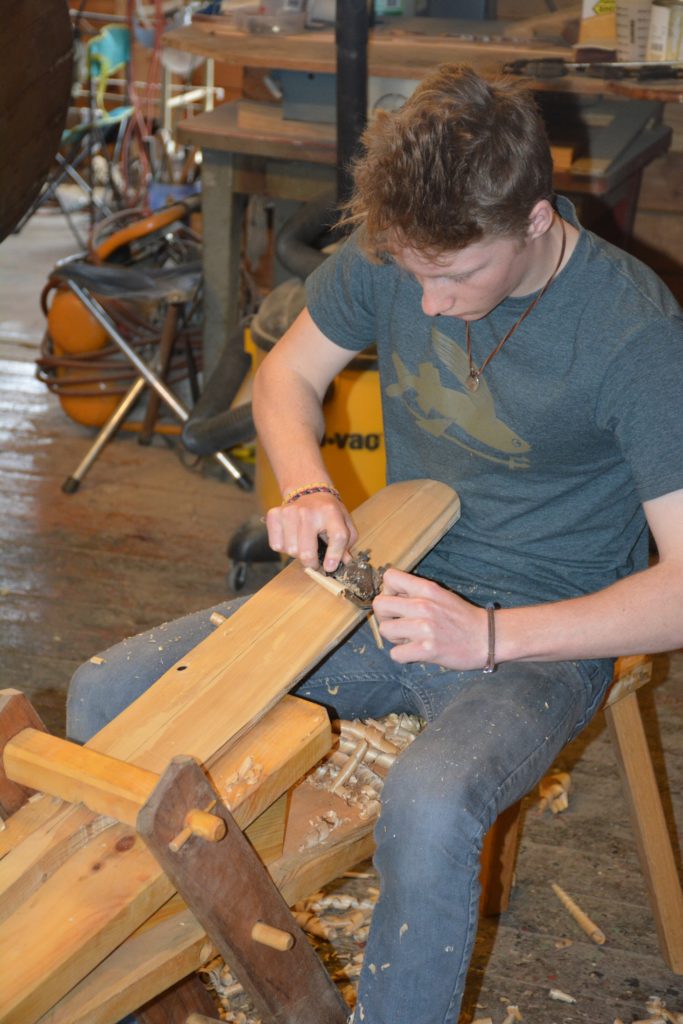
After a soft sanding of the interior, we were ready to oil the cedar, ash, and cherry that make up this canoe. The wood color is amazing, that’s all I can say, just amazing to see. I love the grain, with tree rings laid flat and vertical, popping. I love this. Inside, we add layers of varnish, outside, linseed oil. After some drying time, the boat is ready for the next big steps: Canvas, filler, primer paint, installation of the seat that Mom and I caned, thwarts, at least three coats of final paint and varnish, brass stem bands, and finishing with the installation of the Black Cherry outwales. There will be over 250 hours of work.

Paddling, now in the early evening, I get a sense of how lucky I am. I’m aware of the trees, their scent, shapes and sounds. I’m aware of the wildlife around me. How many pairs of eyes are watching me? They should not be afraid of me, but I understand their caution.
Before me lies my pack basket, a gift from my parents. Within it are treasures I’ve collected, like a great blue heron feather and an American chestnut, still surrounded by its protective needles. The boat is quiet, even with the occasional strike against the rail—wood to wood, not wood to plastic or metal or kevlar. My Dad’s boat has rubbings along the outwales, evidence of his experiences and those of his old friend, Jim Miller. My boat will slowly show its use too.
As I paddle, heading towards the center of the lake, a small shape catches my eye. Its movement is calm, almost unnoticeable. There’s a rhythm that I match. With a pry, I ease the bow to the North. Now I see, it’s clear, and together, in unison, paddle stroke for paddle stroke, both on the righthand side of the canoe, we come closer. Closer and closer.
“Dad!”
“Finn!”
“Cool, you’re here,” I say. “Nice, huh.”
“Yeah, I wouldn’t miss this, never, ever.”
He glides up against my canoe and we grab each other’s hands to wrists to forearms, a canoemen’s sort of handshake. We tie off the boats and after some talk, lean back and look to the stars.
Seen as one….yet the sum.
(Thanks Mr. Smith.)
Reference:
Stelmok, Jerry. The Wood and Canvas Canoe: a Complete Guide to Its History. Harpswell Press, 1988.
A version of this article was previously published in Wooden Canoe (issue 217 Winter 2020; 43:1.) It is reprinted her with the permission of the author.
2 thoughts on “Seen as One…Yet the Sum”
Comments are closed.
Congratulations Finn! You have grown into a wise and talented young man. You should feel very lucky, to be given the opportunity, by both your parents and Patrick Smith, to pursue a passion of canoe building.
Your love of music, nature and the great outdoors will give you the edge, of what most people spend a lifetime pursuing, to find the means to happiness.
With admiration,
Dave and Susie
I will be sure to forward this onto Finn.
Darlene